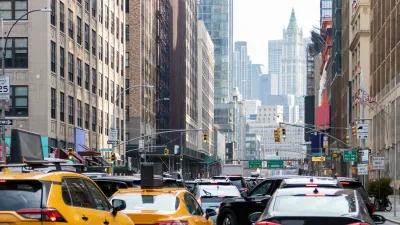School drop-off lines are becoming longer and more isolating than ever.

With more parents than ever before driving their children to school, school drop-offs are becoming a growing pain point for traffic in cities around the country, writes Kendra Hurley in The Atlantic.
The problem is multi-faceted: “For families, the long waits are at best a stressful time suck and at worst a work disruptor. Some city planners take the car line as proof of our failure to create the kind of people-centered neighborhoods families thrive in. Climate scientists might consider it a nitrogen-oxide-drenched environmental disaster. Scolds might rail at what they see as helicopter parents chaperoning their kids everywhere. Some pediatricians might point out the health threats: sedentary children breathing fumes or at risk of being hit by a car.”
For Hurley, another important aspect of the ever-growing school drop-off line is the attendant isolation. “With so many kids now attending schools more than a mile from their home, even the most beautiful, pedestrian-friendly streets may not be enough to lure passengers to the sidewalk. A leisurely stroll to a neighborhood school has been supplanted by the smelly, alienating car line.”
Hurley acknowledges that walking, biking, or public transit are not readily available modes for many American students. “But governments, schools, and communities can create new programs to fill the transportation gap” by proactively arranging walking and biking groups and urging local officials to add better bike and pedestrian infrastructure to their streets. “For families that must drive, the humble carpool can offer the same convenience and safety from crime as driving on your own, while also building camaraderie and minimizing emissions.”
FULL STORY: How School Drop-Off Became a Nightmare

Alabama: Trump Terminates Settlements for Black Communities Harmed By Raw Sewage
Trump deemed the landmark civil rights agreement “illegal DEI and environmental justice policy.”

Planetizen Federal Action Tracker
A weekly monitor of how Trump’s orders and actions are impacting planners and planning in America.

Why Should We Subsidize Public Transportation?
Many public transit agencies face financial stress due to rising costs, declining fare revenue, and declining subsidies. Transit advocates must provide a strong business case for increasing public transit funding.

Understanding Road Diets
An explainer from Momentum highlights the advantages of reducing vehicle lanes in favor of more bike, transit, and pedestrian infrastructure.

New California Law Regulates Warehouse Pollution
A new law tightens building and emissions regulations for large distribution warehouses to mitigate air pollution and traffic in surrounding communities.

Phoenix Announces Opening Date for Light Rail Extension
The South Central extension will connect South Phoenix to downtown and other major hubs starting on June 7.
Urban Design for Planners 1: Software Tools
This six-course series explores essential urban design concepts using open source software and equips planners with the tools they need to participate fully in the urban design process.
Planning for Universal Design
Learn the tools for implementing Universal Design in planning regulations.
Caltrans
Smith Gee Studio
Institute for Housing and Urban Development Studies (IHS)
City of Grandview
Harvard GSD Executive Education
Toledo-Lucas County Plan Commissions
Salt Lake City
NYU Wagner Graduate School of Public Service





























